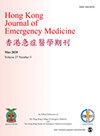A tale of two continents: The performance of six early warning scores in two emergency departments
IF 0.8
4区 医学
Q4 EMERGENCY MEDICINE
引用次数: 0
Abstract
Several early warning scores have been designed to optimize acute care by identifying patients at risk of deterioration. In this post hoc dual center study, we analyzed the performance of six clinical scores (the Goodacre score, Groarke, Worthing Physiological Score, Rapid Acute Physiology Score, Rapid Emergency Medicine Score, United Kingdom National Early Warning Score. The primary outcome is 30-day all-cause mortality after inclusion and data were obtained from previous studies performed at two different emergency departments on two continents (Denmark, Europe, and Hong Kong, Asia). We included 2952 people; 1482 (50.2%) were male, mean age (standard deviation) was 65.7 (18.3) years, and 109 (3.7%) died within 30 days. Mortality rate increased steadily with increasing scores for all six scoring systems in Hong Kong while this was less obvious in Denmark. In all patients, Rapid Acute Physiology Score had the lowest discriminatory power while National Early Warning Score had the highest. National Early Warning Score performed best in Hong Kong while Worthing performed marginally better in Denmark. Surprisingly, the performance of the scoring systems varied considerably, but were largely unaffected by location, and none of them performed close to what clinicians would normally require for predicting 30-day all-cause mortality All scores performed similarly across both centers, with poor prediction of 30-day all-cause mortality. Based on these findings, we believe that clinical scores must be supplemented by either biochemical values or global markers of physiological reserve to reflect reality and to be of true value.两个大陆的故事:两个急诊科的六个早期预警评分的表现
已经设计了几个早期预警评分,通过识别有恶化风险的患者来优化急性护理。在这项事后双中心研究中,我们分析了六种临床评分(Goodacre评分、Groarke评分、Worthing生理评分、快速急性生理评分、快速急诊医学评分、英国国家早期预警评分)的表现。主要终点是纳入后的30天全因死亡率,数据来自两大洲(欧洲的丹麦和亚洲的香港)两个不同急诊科进行的先前研究。我们纳入了2952人;男性1482例(50.2%),平均年龄65.7(18.3)岁,30 d内死亡109例(3.7%)。香港的死亡率随着所有六个评分系统得分的增加而稳步上升,而丹麦的情况则不太明显。在所有患者中,快速急性生理评分的歧视力最低,而国家预警评分的歧视力最高。国家预警评分在香港表现最好,而Worthing在丹麦表现稍好。令人惊讶的是,评分系统的表现差异很大,但在很大程度上不受地点的影响,而且没有一个评分接近临床医生通常预测30天全因死亡率的要求。两个中心的评分相似,对30天全因死亡率的预测很差。基于这些发现,我们认为临床评分必须辅以生化值或生理储备的整体标记,以反映现实并具有真正的价值。
本文章由计算机程序翻译,如有差异,请以英文原文为准。
求助全文
约1分钟内获得全文
求助全文
来源期刊

Hong Kong Journal of Emergency Medicine
EMERGENCY MEDICINE-
CiteScore
1.50
自引率
16.70%
发文量
26
审稿时长
6-12 weeks
期刊介绍:
The Hong Kong Journal of Emergency Medicine is a peer-reviewed, open access journal which focusses on all aspects of clinical practice and emergency medicine research in the hospital and pre-hospital setting.
 求助内容:
求助内容: 应助结果提醒方式:
应助结果提醒方式:


